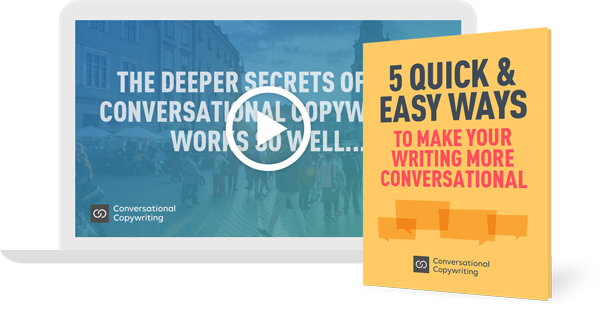
The web is not and never has been a one-way medium where companies get to talk AT an audience.
It’s a two-way medium. Our audiences are as active online as we are.
They get to talk as well… among themselves… to us… and about us.
This has a huge impact on how companies should pitch their products and services online.
And that, in turn, has a huge impact on we, as copywriters, use our craft.
Here, in no particular order, are 7 attributes that make conversational copywriting different… and make it the perfect fit for online marketers.
1. Conversational Copywriting doesn’t work through brute force.
Traditional copywriting is all about writing AT your audience, secure in the knowledge that people can’t write back.
Broadcast copywriting was never – and never could be – conversational. We could never really hope to build anything like a meaningful relationship with our prospects.
As a result, offline copywriting had to perform its magic through brute force. To get results you had to push hard for the sale.
While pushing hard and using brute force worked OK offline, it doesn’t work so well online. Because when they’re online people can shout back, or simply turn you off.
This is why millions of people install ad-blockers. It’s why people unsubscribe from promotional emails. It’s why people become irritated with companies that simply add more noise to the web.
Conversational copywriting isn’t like that.
It’s respectful of the two-way nature of the web. It recognizes that by its very nature the web is social and conversational.
It doesn’t try to win your attention through brute force.
It tries to win by EARNING your attention and interest through honest, two-way communication.
2. Conversational copywriting is copywriting without SHOUTING.
We’ve already talked about brute force. Shouting with your copy is a subset of that.
Here’s an old-school example:
To get your seat at this life-changing event, you MUST SIGN UP NOW.
All loud and shouty. Right?
If I wanted to be more conversational, and to grow a whole different kind of relationship with that person, I might say something more like this.
Any questions? These seats are going fast, so if you have any questions please email me right now at nick@nickusborne.com. Or call me at 000-000-0000.
I still have some urgency in there. But I’m being a whole different person. I’m not shouting from behind a wall… I’m inviting conversation.
You might be thinking, “Sure Nick, but even a small company can’t realistically get into conversation with its customers.”
Sure about that? Philip Krim, the CEO of mattress maker Casper, figures he has personally taken part in text conversations with about 50% of the company’s customers.
Go to the Casper website and you’re invited to get into a live chat with their “Snooze specialists”.
Conversation lies at the heart of their marketing.
3. Conversational copywriting is more accessible than business writing.
At school we are taught to write grammatically. Then, at work, we are schooled in the craft of business writing.
Business writing can be great for communicating internally, or within an industry. It communicates business ideas with clarity. Good business writing avoids confusion and ambiguity.
But online, on a company’s website, its feels overly formal. Business writing is like a secret language between insiders. It feels like a wall, a barrier, between the business and its customers.
Conversational copywriting seeks to lower those walls and barriers. It’s a way of writing that makes the company feel more accessible, friendlier and more welcoming.
This is particularly important on pages like the About page on a business website. There, and anywhere else a company talks about itself, there is a temptation to fall back on traditional, formal business writing.
But like I said, that just creates distance. You’re better off creating a greater sense of accessibility by being more conversational in how you write.
And nothing is more accessible than conversation… because it’s something we all do, every day.
It’s a way of communicating that everyone has in common.
4. Conversational Copywriting feels more like spoken language.
The style and tone of conversational copy isn’t taken from old-school, loud and shouty copywriting.
Nor is it taken from the more formal structure and correctness of business writing.
It feels far more like spoken language… the way we talk with colleagues around the water cooler or over coffee. The way we talk with family and friends at home or at a backyard BBQ.
Not so much emphasis on grammar. No worries about correct punctuation. (Missing verbs? Oops!)
Just make it sound like it’s rolling off the tongue. Make it feel natural.
When you do that, you dramatically shorten the distance between yourself and your reader, viewer or listener.
Read your favorite blogger. Watch your favorite YouTuber. Listen to your favorite podcaster.
I bet they all come over sounding natural and conversational.
As online copywriters and marketers we need to follow their example.
5. Conversational copywriting carries a natural enthusiasm.
People sometimes tell me they don’t see how they can work at selling a product or service if they are “constrained” by having to be conversational.
Really?
Think about the last time you tried to persuade your spouse to watch the movie YOU wanted to see, and not the one he or she wanted to see.
Or about how you tried to get your teenager to go on a family camping trip.
Or when you were arguing with a buddy over which is the best heavy metal band EVER.
In each case you were in conversation. And in each case you were selling. You were selling your own point of view, your own preference or opinion.
Best of all, in each of those conversations, your natural enthusiasm shone through. You got excited and passionate.
You were selling your heart out….but without the formal blah blah of being a professional copywriter. You just opened your heart and let rip.
That’s the central core of conversational copywriting.
6. Conversational copywriting allows people to lower their defenses.
Do we trust salespeople? Of course we don’t.
That’s one of the legacies of old-school, one-way, broadcast marketing and copywriting.
Car salesmen? Nope.
Telemarketers? Definitely not.
A direct mail package selling me the timeshare deal of a lifetime? I think not.
None of us trust companies that try to sell to us with their tired, pushy, one-way methods.
When we’re online we have a heightened sensitivity to BS. And when we don’t want to sniff out the nonsense one ad at a time, we install one of those ad-blockers.
How do you get past those defences? You do it by getting into real conversations with your customers and prospects.
And your starting point on that journey is to SOUND conversational when you write.
People may not trust your business right away. But if they like the sound of your voice, they are more likely to start trusting YOU.
7. Conversational copywriting invites REAL conversation.
You can write in a conversational tone without actually being in conversation with someone.
This post – the one you’re reading right now – is written in a fairly casual, conversational tone. Not too salesy. Not too business-like.
It’s fairly close to the way I would cover the same ground if I were talking to you over coffee, or from the stage at an event.
The way I write is pretty close to the way I speak.
But when I write like this I’m also extending an invitation… “Talk with me”.
Sometimes that can take place through the comment stream on a blog or a social media stream.
Or that conversation could happen through a chat application. Or by phone.
Get into a real conversation and now you’re building incredibly deep bonds of trust and loyalty between your audience and your business.
Wrapping it up…
There was a certain approach to copywriting that worked just fine with traditional, one-way, broadcast media.
But that same, hard-charging approach simply doesn’t work as well online.
The online environment is two-way. It’s social and conversational by its very nature.
And that means a conversational approach to copywriting will always serve you better.
Put simply, in the online world conversational copywriting rules.
NOTE: If you’d like to add the craft of conversational copywriting to your online writer’s toolbox, find out about the Conversational Copywriting course here…
